
State of Side Hustles in the UK in 2025
For some, side hustles are an extra job acting as a small way to add to savings pots. For others, they’re the first rung on the ladder to full-time self-employment.
In both of these situations, having a second job is more than just a hobby – it can sometimes be the difference between living comfortably and living paycheck to paycheck. Looking at the numbers, in the UK, the Office for National Statistics reported that in April to June 2025, 1.32 million workers had a second job.[1] For people with a second job, or those who are pursuing a side hustle as a small business, Remitly now offers reliable global business payments to pay suppliers or talented freelancers around the world.
These additional income streams can come through things like blogging, hosting people in spare rooms/property, and of course, selling items online. But these are just the tip of the iceberg in today’s side hustle climate.We understand how important it is to have reliable ways to manage your finances, so we wanted to learn more about side hustles in the UK. To do so, we commissioned a survey looking at how people’s second jobs were helping them and what actual earnings look like.
We spoke to over 1,000 people in the UK to build a picture of the state of side hustles today. We asked survey respondents questions about their side jobs, including how much time they spend working and how much money they earn.
Key takeaways
- The majority of side hustles require little to no upfront investment, with nearly half of the respondents (49%) saying they didn’t need to pay anything to get started.
- Over half (53%) of the people surveyed said they would consider moving abroad if it meant better opportunities for their side hustle.
- Over two-thirds (68%) of people report less than £500 a month from side hustles, with a further 17% earning between £999 and £1,999 per month on top of their primary source of income.
- On average, from our dataset, people in the UK with a side hustle earn £367.88 a month.
56% of people say money is the main motivator for a side hustle
| What is your main motivation for having (or wanting) a side hustle? | Respondents (%) |
|---|---|
| To earn extra money | 56% |
| To turn a hobby into income | 23% |
| To gain new skills | 10% |
| To have more financial security | 9% |
| To eventually turn it into a full-time job | 2% |
| Other (please specify) | 0% |
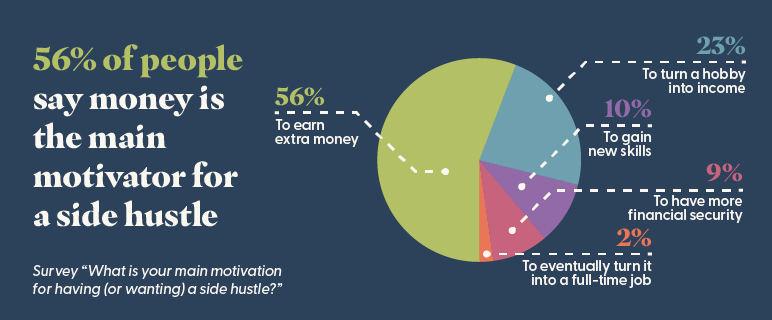
Key reasons people start a side hustle:
- Money is the main motivation: Over half (56%) of respondents say their primary reason for having a side hustle is to earn extra income. With the rising cost of living, stagnant wages, and growing financial pressure on households, it's likely no surprise that people are turning to side hustles to help cover essentials, build savings, or meet long-term financial goals.
- 23% turn a passion into a side hustle: For nearly a quarter of people, side jobs are also a way to make money from something they already love doing. This reveals that for the majority of people, starting a side hustle is not just a monetisation of an already existing hobby, but could be a learned skill or simply to earn money.
- Women more often pursue passion projects: 27% of women compared to 19% of men say their side hustle stems from a hobby or personal interest.
- Money matters more with age: 70% of 45-54-year-olds say income is the main reason, compared to 42% of those aged 25-34. This is likely due to increased financial obligations like mortgages, children, or retirement savings that older individuals face. Meanwhile, younger adults in their late 20s and early 30s may still be exploring career paths.
- Skills matter more than cash for the youngest workers: 22% of 18-24-year-olds start a side hustle to learn new skills. For many younger workers, side hustles are seen as learning opportunities or stepping stones into entrepreneurship, where traditional jobs may not offer the same experience.
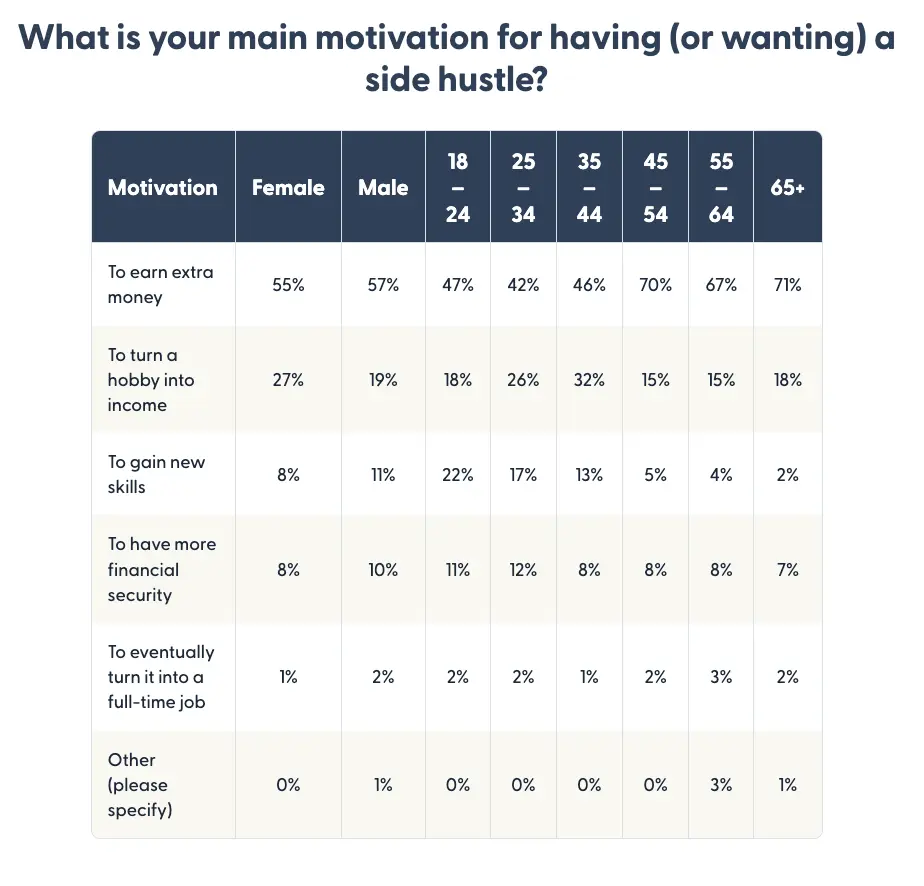
Over a third of people make less than £100 a month
Most side hustles in the UK generate modest income, but for many, that's the point. Our data shows 68% of people earn up to £500 a month, with 36% making less than £100 and 32% making between £100 and £499. Only a small minority crosses into four-figure territory. Even though big earnings are rare, small amounts can make a meaningful difference and provide enough extra cash to manage financial commitments without needing to take on another full-time job.
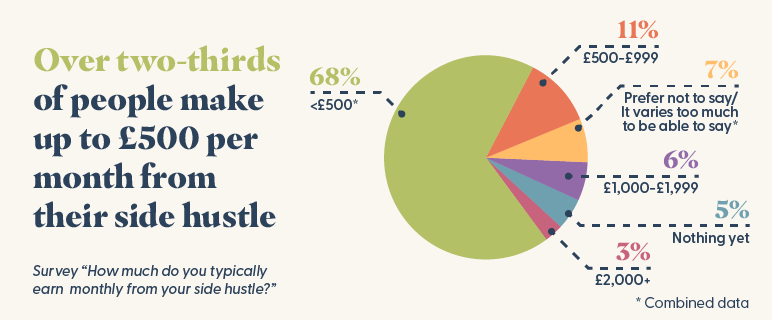
| How much do you typically earn monthly from your side hustle? | Respondents (%) |
|---|---|
| Nothing yet | 5% |
| Less than £100 | 36% |
| £100 - £499 | 32% |
| £500 - £999 | 11% |
| £1,000 - £1,999 | 6% |
| £2,000+ | 3% |
| Prefer not to say | 1% |
| It varies too much to be able to say | 6% |
How much do people earn from a side hustle?:
- Almost a third (32%) of people earn between £100 and £499: Most side hustlers are bringing in modest but regular income, which could be enough to cover a weekly shop or support energy bills, for example.
- Over one in three (36%) earn less than £100 each month: Many side hustles start slow or stay small by design. This suggests that income from second jobs can be limited by time, experience, or the type of work available. Our data shows these types of hustles often include casual selling, small-scale freelancing, completing paid online surveys, or low-demand gig work.
- Less than one in ten (9%) make over £1,000 per month, and only 3% break the £2,000 barrier: meaning high earners are rare when it comes to side hustles.
- Income from side hustles isn’t always consistent: Unlike salaried jobs, side hustles don’t always guarantee a weekly or monthly income. 6% of the people we surveyed said their earnings vary too much to be sure how much they actually make, but this could be due to the flexibility of choosing when and how often they work.
How much do you typically earn monthly from your side hustle?
| Monthly income | Female | Male |
|---|---|---|
| Nothing yet | 6% | 4% |
| Less than £100 | 38% | 34% |
| £100 - £499 | 33% | 31% |
| £500 - £999 | 9% | 14% |
| £1,000 - £1,999 | 4% | 8% |
| £2,000+ | 4% | 2% |
| Prefer not to say | 1% | 0% |
| It varies too much to be able to say | 5% | 7% |
Gender pay gap in UK side hustle earnings
- Gender gap in earnings: Men (24%) are more likely to earn more than £500 a month than women (17%). This could reflect broader issues like time availability, responsibilities outside of work, or differing access to professional networks they can capitalise on.
- Men earn an average of £393.70 a month from a side hustle, compared to women's average of £339.77. Considering the gender pay gap in the UK as of 2024 was 7%, this suggests the gap in side income could be much larger (15.9%)
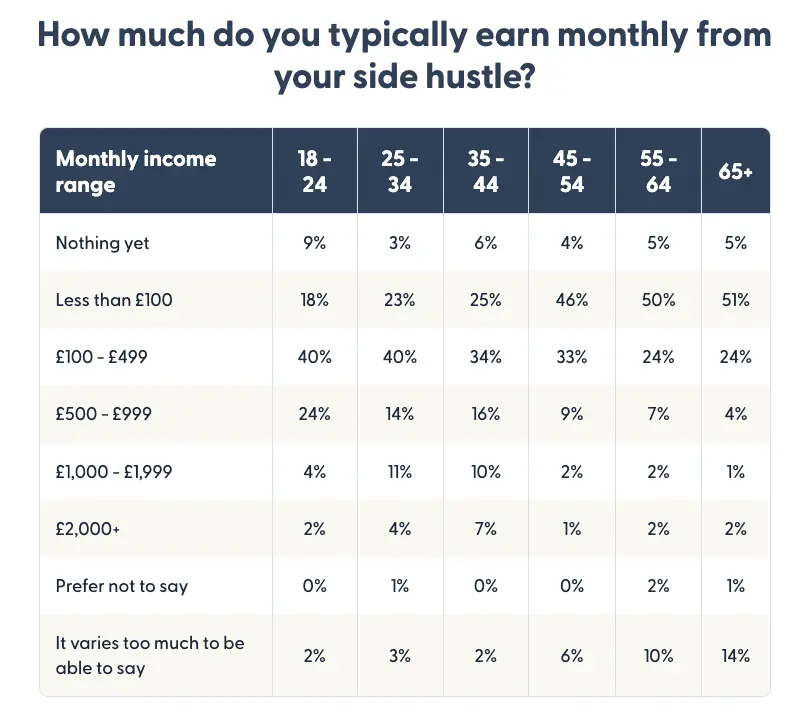
Age pay gap in UK side hustle earnings
- Younger people earn more from side hustles: Of our survey respondents, almost a quarter (24%) of 18-24-year-olds earn between £500 and £999 per month, compared to just 16% of 35-44-year-olds. Given that online platforms are constantly changing, this could be due to younger generations' comfort with digital tools, social networks, and tech-driven side jobs. Or it could be reflective of how younger people often have lower full-time salaries so they need to supplement their income more.
- Older people tend to earn less: Older individuals (half of those aged 55-64 and 51% of those over 65) earn less than £100 per month. Over half (55%) of those aged 65 and above spend between one and five hours per week on their side job, compared to just over two-thirds (36%) of those aged 18-24 and 25-34.
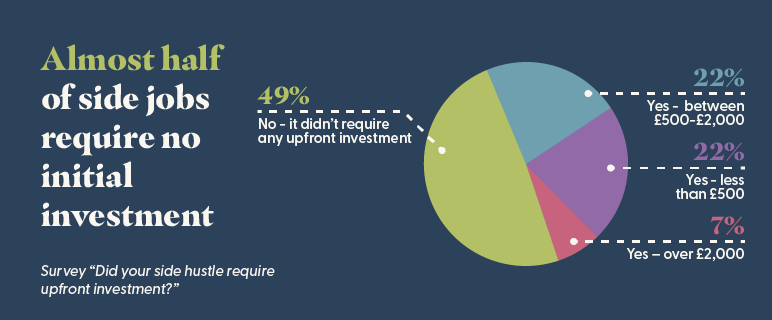
Almost half of side jobs require no initial investment
- Most side hustles require little investment upfront: Starting a side hustle doesn’t necessarily require significant savings. Almost half (49%) of survey respondents with a side hustle faced no upfront investment, and over one-fifth (22%) initially invested less than £500.
| Did your side hustle require upfront investment? | Respondents (%) |
|---|---|
| No – it didn't require any upfront investment | 49% |
| Yes – less than £500 | 22% |
| Yes – between £500 – £2,000 | 22% |
| Yes – over £2,000 | 7% |
Older side hustlers prefer side hustles with no upfront cost
- Older age groups often start without any investment: A third (33%) of those aged 35-44, over half (57%) of those aged 45-54, and over two-thirds (68%) of 55-64-year-olds made no initial investment at all. This could indicate that older age groups with side jobs are more likely to choose side jobs that capitalise on their skills and abilities, with many citing completing surveys as their hustle. This could also demonstrate a link between age and risk-taking.
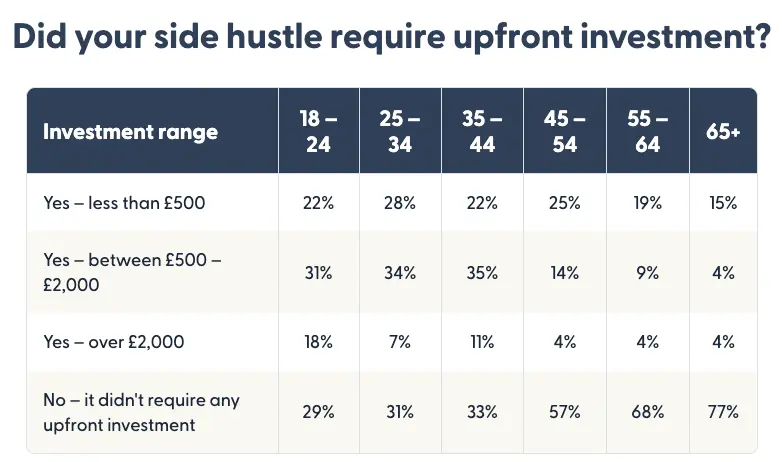
UK regional side hustle insights
- Regional location can impact investment: People with a side hustle in South West England are most likely to make no upfront payment, at almost two-thirds (61%). That figure is below half in South East England (47%) and Central England (49%). The proportion of people in South East (24%) and Central England (26%) who choose e-commerce as a side hustle is higher than that of South West England (21%).
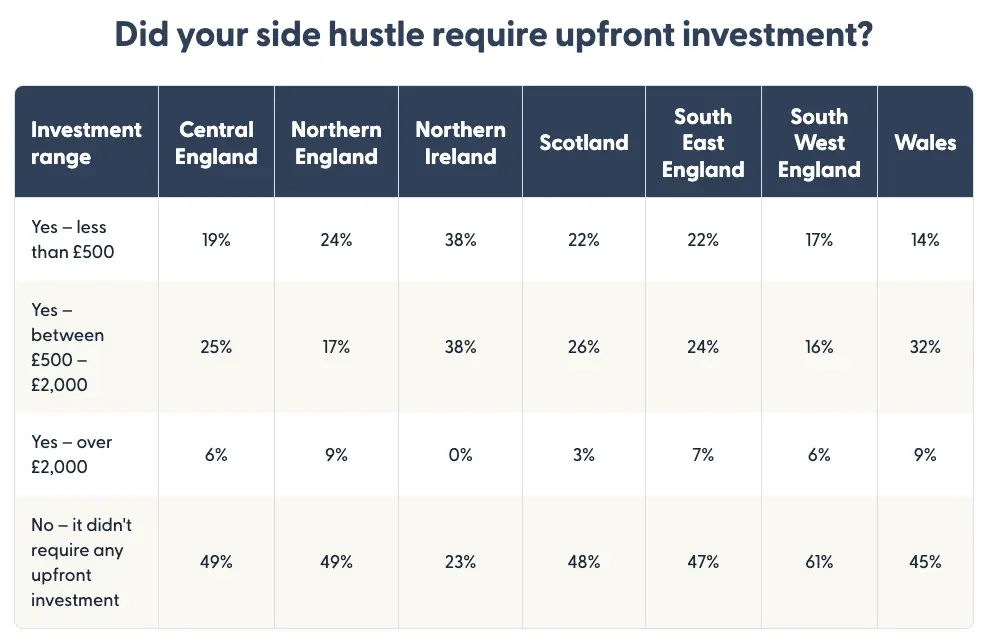
Which side hustles are increasing the most in interest?
While traditional side hustles like babysitting remain strong, Airbnb hosting has surged in popularity when looking at Google search data. Over the past year, monthly searches focused on making money on Airbnb in the UK rose from 130 to 1,580, a 1,115.4% increase. These searches were for terms such as ‘how to start renting on Airbnb’.
As the short-term rental and vacation lets market continues to bounce back, people with spare rooms or holiday homes increasingly see hosting as a lucrative and flexible income source.
Translating work has also grown in popularity the last year. UK search interest grew by 553.5%, likely driven by increasing demand for multilingual content online. These searches were for phrases like ‘make money by translating’.
Meanwhile, TikTok monetisation saw UK search growth nearly double, indicating more people are exploring content creation or TikTok shop selling as a legitimate side hustle. Many people were searching for queries like ‘earn money with TikTok’.
Airbnb hosting is the side hustle growing the most in interest, with Google searches rising over 1,000% year over year
| Rank | Side hustle | Year-on-year change (July 24 – June 25) |
|---|---|---|
| 1 | Renting on Airbnb | 1,115.4% |
| 2 | Translating | 553.5% |
| 3 | TikTok | 98.4% |
| 4 | Mystery shopping | 83.0% |
| 5 | Content creation | 31.6% |
| 6 | Stock market trading | 28.9% |
| 7 | Voice acting | 26.3% |
| 8 | Babysitting | 10.2% |
| 9 | Selling crafts | 9.1% |
| 10 | Pet sitting | 6.3% |
Which side hustles get the most Google searches in the UK?
Blogging is the side hustle generating the most interest in the UK this year, with over 34,850 searches for queries like ‘how to start blogging’ and ‘earn money by blogging’. Despite newer trends for side hustles like selling online, this more traditional method of bringing in an extra source of income remains widespread. It has almost double the number of searches as the next most popular side hustle, dropshipping, which received over 21,600 searches in 2024/25.
Blogging’s continued popularity may be due to its low startup costs, flexible schedule, and potential for passive income through ads or affiliate marketing. However, with many bloggers relying on Google for traffic and subsequent income, the search giant’s constant algorithm changes and high competition mean that while blogging attracts many for its low startup costs and flexible schedule, many might struggle to succeed.
As one of the fastest-growing side hustles, TikTok is one of the most popular streams of extra income overall. There were 16,230 searches in the UK for queries related to making money from TikTok, including ‘earn money with TikTok’, in the last 12 months.
Forex trading is also a side hustle people are interested in researching, with 5,950 searches last year for terms like ‘how to start forex trading’. This can be a high-risk activity and requires high-levels of financial knowledge to undertake successfully. This popularity is likely increased by social media influencers pushing forex trading as a side hustle and then profiting off the courses they sell on the matter. Searches for this are down 23.5% year-on-year, indicating a gradual decrease in popularity, however, other financial side hustles are picking up.
Stock market trading received 4,190 searches in 2024/25, up 28.9% from the previous year. Unfortunately, those researching ways to make stock market trading a side hustle likely lack the knowledge to earn income from this activity. Statistics put the stock market day trading success rate as low as 3% highlighting the potentially extreme risk levels.[2]
This content is for informational purposes only and does not constitute financial advice. Trading in stocks, forex, and other financial instruments carries risks and may not be suitable for all individuals. Please conduct your own research or consult a licensed financial advisor before making investment decisions.
Blogging tops the list of interest in UK side hustles
| Rank | Side hustle | Total number of searches (July 24 – June 25) |
|---|---|---|
| 1 | Blogging | 34,850 |
| 2 | Dropshipping | 21,600 |
| 3 | TikTok | 16,230 |
| 4 | Doing surveys | 6,660 |
| 5 | Forex trading | 5,950 |
| 6 | Dog walking | 4,850 |
| 7 | Stock market trading | 4,190 |
| 8 | Mystery shopping | 2,910 |
| 9 | Translating | 2,810 |
| 10 | Tutoring | 2,220 |
Selling items online is the UK’s most active side hustle
- E-commerce is the most popular side hustle: Almost a quarter (23%) of people in our survey choose this route. It’s especially popular among 45-54-year-olds, over a third (37%) of whom rely on it for additional income. This can involve profiting from hobbies like crafting, vintage collecting, or small-scale item production.
23% of people choose e-commerce as their side hustle
| What type of side hustle are you currently involved in (or interested in starting)? | Respondents (%) |
|---|---|
| E-commerce (Etsy, eBay, Depop, etc.) | 23% |
| Freelancing (writing, design, marketing, etc.) | 21% |
| Property rental (Airbnb, holiday lets) | 9% |
| Content creation (YouTube, TikTok, Instagram) | 10% |
| Online tutoring or teaching | 7% |
| In-person services (Pet sitting, beauty, cleaning, etc.) | 11% |
| Other (please specify) | 19% |
Freelancing is most popular among those under 45 years old
- Freelancing is also popular among younger people: Over a fifth (21%) of people earn an extra income from jobs like writing and design. It is most common among younger groups, including those aged 25-34 (41%). Those aged 18-24 (29%) and 35-44 (28%) also cite freelancing as their main side hustle.
- Some cities are more popular than others for holiday rentals: In Newcastle, holiday rentals are booming, with almost a fifth (19%) of side hustlers renting out homes or rooms on platforms like Airbnb. In pricier cities like London or Birmingham, tighter housing markets limit this option, with only around one in 10 using property rentals as their side hustle.
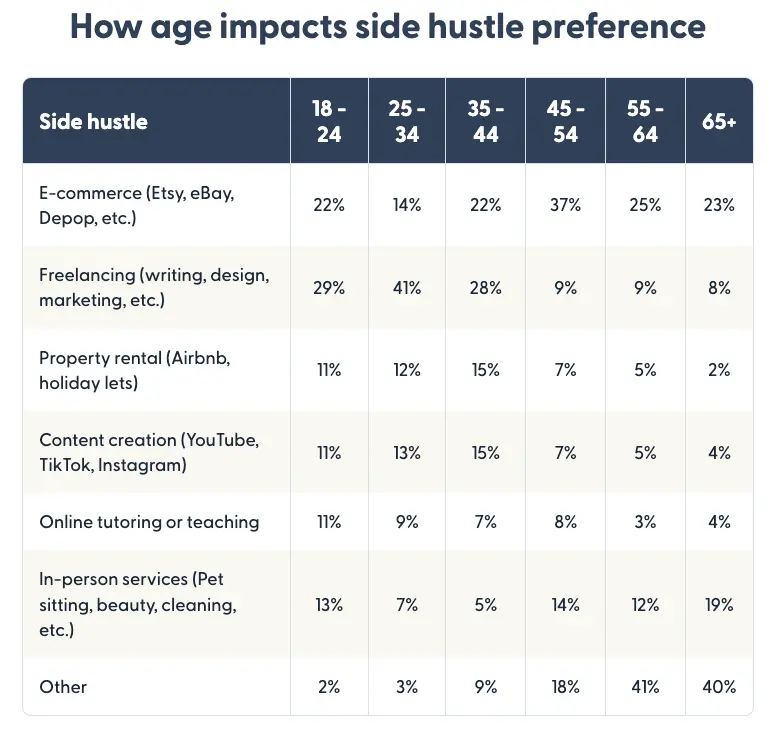
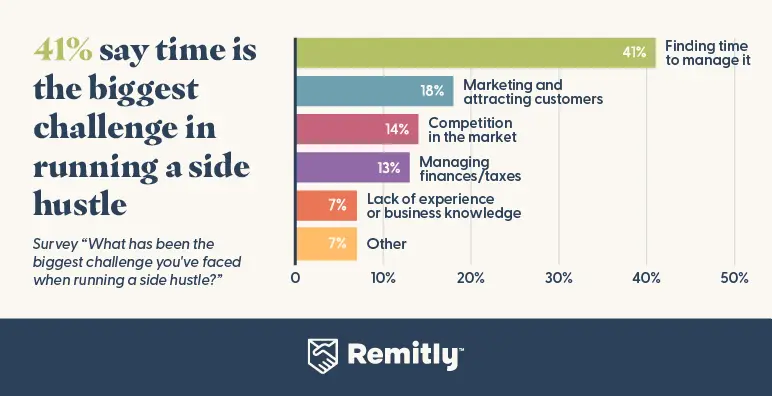
Time is the biggest challenge in running a side hustle
- Lack of time is the biggest obstacle: Over two-fifths (41%) of respondents said that finding enough time to manage their side hustle was the biggest challenge, while a further 27% said that having more time would be the most encouraging factor in helping them start or grow their business.
What has been the biggest challenge you've faced when running a side hustle?
| Challenge | Respondents (%) |
|---|---|
| Finding time to manage it | 41% |
| Marketing and attracting customers | 18% |
| Competition in the market | 14% |
| Managing finances/taxes | 13% |
| Lack of experience or business knowledge | 7% |
| Other (please specify) | 7% |
For the UK to have more side hustles, people would want more time, less work, and marketing insights
- People want more time and less work to dedicate to side hustles: 27% say having more time would help them start/grow a side hustle. Another 22% said the biggest factor would be having more flexible hours in their main job, while 21% said having insights into marketing and reaching customers would be the biggest kick-starting factor for them.
Which factor would most encourage you to start or grow a side hustle?
| Encouraging factor | Respondents (%) |
|---|---|
| More time to devote to it | 27% |
| More flexible working hours in my main job | 22% |
| Easier ways to market and reach customers | 21% |
| Better access to funding or financial support | 10% |
| Access to professional advice and resources | 8% |
| Increased demand for freelance/side businesses | 8% |
| Other | 4% |
How much time do people dedicate to side hustles in the UK?
- Side hustles can feel like a part-time job: Most side hustlers dedicate between one and five hours (43%) or 6 to 10 hours (40%) per week to their side gig. Those aged 25 to 34 appear least affected by time constraints, with only a third citing this as their biggest obstacle, whereas almost half (49%) of those aged 45 to 54 identified time as their main challenge.
- Marketing is a common challenge for younger people: 18% of respondents identify this as their biggest hurdle. This is particularly common among 25 to 34-year-olds, where one in three struggles with this aspect of running a side hustle. In an increasingly competitive digital environment, attracting and converting attention into revenue is a growing concern for younger entrepreneurs.
More than half would move abroad for side hustles
Moving abroad may give some people the space, motivation, or community to grow a side hustle. Many move to places like Bali in Indonesia to grow their freelancing work, for example, with the island describing itself as ‘one of the most popular destinations in the world for digital nomads, freelancers, and remote workers’.
- Many would relocate for the right opportunity: More than half (53%) of those surveyed said they would consider moving abroad for their side hustle, 25% would consider it, while 47% said they would not explore this. Interest in relocating is lowest among those aged 65 and over, with 87% preferring to stay in their home country. In contrast, nearly half (45%) of those aged 35 to 44 said they would definitely consider a move. This suggests that many people are open to flexible, location-independent side hustles that offer greater lifestyle or financial benefits outside the UK.
Remitly’s experts give five tips to start and sustain your side hustle
Starting and running a side hustle can be exciting but unpredictable. Remitly’s finance experts provide insights to help you build a sustainable income. These strategies can help you manage your money and time more effectively, bringing you closer to achieving your goals.
- Start small and test your idea: Avoid big financial commitments upfront. Test your concept with a low investment to see if there is genuine interest or demand. Consider using free or low-cost methods to validate your idea before spending money, like speaking to someone successful in the same industry or using online market research tools. If you are selling a product, try a limited batch first or implement a pre-order model to gauge interest.
- Track everything: Use budgeting tools or a basic spreadsheet to track income, expenses, and time spent. This will help you understand your side hustle’s actual profitability. Use income trackers online, many of which are free to access, to input your spending and profit, and clearly see whether your time investment is worth the return.
- Save for taxes: In the UK, self-employed or side hustle income over £1,000 per year needs to be declared. Set aside around 20-30% for taxes. Many new side hustlers underestimate tax calculations. Consider setting up a separate savings account for tax contributions and tracking allowable expenses to reduce your bill. You may also need to register for Self Assessment with HMRC.
- Diversify income sources: Don’t rely on one platform. Algorithms, platform policy changes, or market saturation can affect your income stream overnight. To stay resilient, explore complementary revenue streams (like coaching, subscriptions, or licensing your content/skills).
- Be smart about managing your side hustle income: Be intentional with your earnings, regardless of whether you're saving, reinvesting, or sending money to loved ones. If possible, create a separate business account, pay yourself a regular ‘salary’ from side hustle profits, and consider your long-term goals. Knowing where your money is going helps build financial stability.
Methodology
Remitly supports millions of people worldwide in managing their money across borders, whether that is saving for the future or building new income streams.
Side hustles have become an essential way for many to boost earnings, pursue passions, or prepare for bigger business ventures. To better understand the landscape, we set out to uncover where running a side hustle is most lucrative and where financial barriers may make it more challenging.
A survey was issued to over 1,000 adults in the UK, who answered either “Yes” or “I used to, but not anymore” to the screener question “Do you currently have a side hustle alongside your main source of income?”. These respondents were then asked questions on their side hustles.
To estimate average monthly earnings from side hustles by gender, each income band was assigned a midpoint value. These midpoint values were multiplied by the percentage of male and female respondents in each band to produce weighted averages. Respondents who selected “Prefer not to say” or “It varies too much” were excluded from the calculation, as no numeric value could be assigned.
The number of UK Google searches for each side job was sourced using Google Ads Keyword Planner. The periods compared were July 1 2023, to June 30 2024 and July 1 2024, to June 30 2025. The search terms used were ‘How to start [side hustle]’, ‘Make money with/by [side hustle]’, ‘Earn money with/by [side hustle]’, ‘[Side hustle] income’, and ‘[Side hustle] earnings’.
Side hustles have become an essential way for many to boost earnings, pursue passions, or prepare for bigger business ventures. To better understand the landscape, we set out to uncover where running a side hustle is most lucrative and where financial barriers may make it more challenging.
A survey was issued to over 1,000 adults in the UK, who answered either “Yes” or “I used to, but not anymore” to the screener question “Do you currently have a side hustle alongside your main source of income?”. These respondents were then asked questions on their side hustles.
To estimate average monthly earnings from side hustles by gender, each income band was assigned a midpoint value. These midpoint values were multiplied by the percentage of male and female respondents in each band to produce weighted averages. Respondents who selected “Prefer not to say” or “It varies too much” were excluded from the calculation, as no numeric value could be assigned.
The number of UK Google searches for each side job was sourced using Google Ads Keyword Planner. The periods compared were July 1 2023, to June 30 2024 and July 1 2024, to June 30 2025. The search terms used were ‘How to start [side hustle]’, ‘Make money with/by [side hustle]’, ‘Earn money with/by [side hustle]’, ‘[Side hustle] income’, and ‘[Side hustle] earnings’.
- [1] The Office for National Statistics LFS: Workers with second jobs: UK
- [2] Investopedia, Is Day Trading Profitable?



